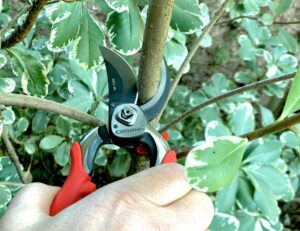Bring your overgrown lilacs, forsythia, mock orange, pieris and other spring flowering shrubs down to size while maintaining their natural beauty and spring floral display.
Prune spring blooming shrubs right after flowering for maximum flowering. These shrubs set their flower buds in summer so pruning at other times of the year reduces or eliminates the spring floral display. Major pruning on these shrubs can also be done in late winter. It’s easier to see what needs cutting and the plants respond well to pruning at this time of the year. You’ll just eliminate some of the spring flowers.
Summer blooming shrubs like potentilla, beautyberry, and Annabelle-type hydrangeas flower on new growth. Prune these, when needed, in late winter or early spring before growth begins or anytime during the dormant season.
Make sure you have the proper tools and safety equipment before making the first cut. Protect your eyes and hands with safety glasses and gloves. Then make sure your pruning tools are clean and sharp. Using the right pruning tool for the job helps ease muscle strain and fatigue while making proper cuts that close quickly. This will reduce the risk of insects and diseases moving into the plant.

Photo credit: Corona Tools
Use bypass pruners to cut small stems that are 1/2-inch diameter or less. These have two sharp blades, like scissors, and make clean cuts that close quickly. Employ a bypass lopper like Corona® Tools’ ClassicCUT® SL15167 with soft grips that fit well and will cut limbs up to 1 ¾” in diameter. Loppers have long handles that give you greater leverage and extend your reach.
You will need a pruning saw when doing renewal pruning. A short-bladed saw makes it easier to access and cut larger stems to ground level. Look for a saw, like the RazorTOOTH Saw® RS16150, with a pull stroke cutting action and ergonomic handle. It makes fast and easy cuts and minimizes hand fatigue.
Once you have your tools, you are ready to start pruning. Reduce the height and leggy growth on overgrown suckering shrubs over the next three years. This type of renewal pruning is better for the plant and most gardeners find it less stressful for them as well.
Remove one third of the largest and oldest stems to ground level each year for three years with renewal pruning. If your shrub has twelve stems, you will prune four of these back to the ground this year, four more the following year, and remove the last four older stems the third year. By the end of the three years, you have a smaller shrub with leafy stems from ground to tip and flowers at a level you can enjoy.
Start by removing any crossed or dead branches. Disinfect tools with a 70% alcohol or disinfectant spray between cuts, if you suspect the plant is suffering from disease. This will help reduce the risk of spreading the disease throughout the plant.
You can stop pruning at this point and continue renewal pruning next year in late winter. If you decide to continue, remove a few more of the older stems to ground level. Taking these stems back to the ground encourages new growth at the base of the plant.
Minimize additional pruning at this point. You can reduce the height on any wayward branches as needed. Make your cut on a slight angle above an outward facing bud or stem. This encourages growth away from the center of the plant, reducing the risk of crossing branches in the future.
Maintain the size and prevent leggy growth with regular pruning in the future. Just remove a few older stems to ground level every year or two. Investing a bit of pruning throughout the life of your plants helps boost their heath, beauty, and your enjoyment.
Melinda Myers has written more than 20 gardening books, including the recently released Midwest Gardener’s Handbook, 2nd Edition and Small Space Gardening. She hosts The Great Courses “How to Grow Anything” DVD series and the nationally-syndicated Melinda’s Garden Moment TV & radio program. Myers is a columnist and contributing editor for Birds & Blooms magazine and was commissioned by Corona Tools for her expertise to write this article. Myers’ web site is www.MelindaMyers.com.
